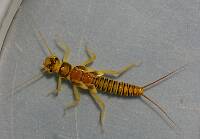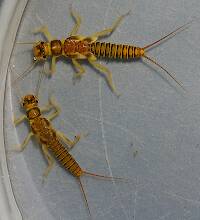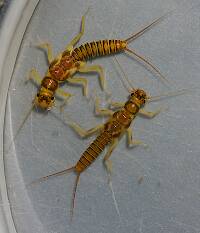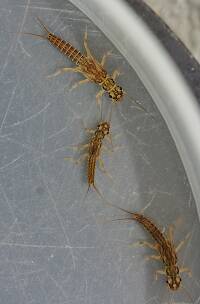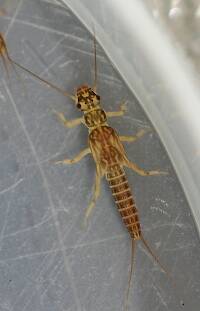
Hex Mayflies
Hexagenia limbata
The famous nocturnal Hex hatch of the Midwest (and a few other lucky locations) stirs to the surface mythically large brown trout that only touch streamers for the rest of the year.
Featured on the forum

This one seems to lead to Couplet 35 of the Key to Genera of Perlodidae Nymphs and the genus Isoperla, but I'm skeptical that's correct based on the general look. I need to get it under the microscope to review several choices in the key, and it'll probably end up a different Perlodidae.

Troutnut is a project started in 2003 by salmonid ecologist Jason "Troutnut" Neuswanger to help anglers and
fly tyers unabashedly embrace the entomological side of the sport. Learn more about Troutnut or
support the project for an enhanced experience here.
Wiflyfisher on Jun 5, 2007June 5th, 2007, 12:11 pm EDT
Over the past weekend it was cold and pouring rain and I decided it was time re-read Gary LaFontaine's "The Dry Fly New Angles". I had not looked at this book in several years and thoroughly enjoyed reading it again.
One of Gary's favorite patterns for large mayflies was called the "Mess". It looks really odd with it's forward slanted wing and hackles, but Gary said he gave up using the extended body imitations on larger mayflies for this pattern and had great success with it. Since I really don't want to tie anymore extended body patterns for the upcoming brown drakes and Hex hatches I decided to whip up some of Gary's pattern called the "Mess".
Gary talked about how the forward slanted wing and flush floating body are major triggers to excite trout into action. His logic makes total sense, although the fly looks really odd. It is the kind of fly you don't want to show off to anyone, but if it works what the heck!
I am curious to know if anyone else has tried this pattern?
One of Gary's favorite patterns for large mayflies was called the "Mess". It looks really odd with it's forward slanted wing and hackles, but Gary said he gave up using the extended body imitations on larger mayflies for this pattern and had great success with it. Since I really don't want to tie anymore extended body patterns for the upcoming brown drakes and Hex hatches I decided to whip up some of Gary's pattern called the "Mess".
Gary talked about how the forward slanted wing and flush floating body are major triggers to excite trout into action. His logic makes total sense, although the fly looks really odd. It is the kind of fly you don't want to show off to anyone, but if it works what the heck!
I am curious to know if anyone else has tried this pattern?
John S.
https://WiFlyFisher.com
https://WiFlyFisher.com
JAD on Jun 5, 2007June 5th, 2007, 2:34 pm EDT
Hi John
I have not used Garys fly but I personally used my own version for quite a few years and is a producer for me.
John
They fasten red (crimson red) wool around a hook, and fix onto the wool two feathers which grow under a cock’s wattles, and which in colour are like wax.
Radcliffe's Fishing from the Earliest Times,
Wiflyfisher on Jun 5, 2007June 5th, 2007, 3:49 pm EDT
Thanks for your response.
Over the years my favorite large mayfly pattern has been an extended body comparadun. ( I had to search far and wide for the right deerhair for tying really good, large comparadun patterns.) This year I vow to use the "Mess". Besides, I am good at tying messy flies. :-)
Over the years my favorite large mayfly pattern has been an extended body comparadun. ( I had to search far and wide for the right deerhair for tying really good, large comparadun patterns.) This year I vow to use the "Mess". Besides, I am good at tying messy flies. :-)
John S.
https://WiFlyFisher.com
https://WiFlyFisher.com
Invicta on Jun 6, 2007June 6th, 2007, 6:13 am EDT
John,
I did use the ‘mess’ during the mid 90’s for several hatches: Hexagenia, Ephemera and D. grandis. The pattern worked well enough, with a couple of caveats. I substituted teal for the mallard, and sandwiched it between wraps of hackle to add support. Otherwise the teal tended to collapse after a fish, or two. Gary had used the hackle only on the forward portion of the fly. And I changed the tail material to moose mane for durability.
For the Hex hatch it was marginal, not having the size or motion need to match the hatching natural. I found I had better success with the nymph. Those mayflies make an audible ‘pop’ and quite a disturbance when they hatch. The ‘mess’ didn’t come close to matching that performance. For Ephemera I don’t think the triggers of the appearance of the body color made any difference as the hatch occurred so late in the day. Shape was more important, and I’m not sure that other patterns would not have worked better. For the Green Drake I’ve gone almost exclusively to the nymph and cripple. There is just too much fishing pressure for other than the best imitation where I fish that hatch.
Hope that helps,
John
I did use the ‘mess’ during the mid 90’s for several hatches: Hexagenia, Ephemera and D. grandis. The pattern worked well enough, with a couple of caveats. I substituted teal for the mallard, and sandwiched it between wraps of hackle to add support. Otherwise the teal tended to collapse after a fish, or two. Gary had used the hackle only on the forward portion of the fly. And I changed the tail material to moose mane for durability.
For the Hex hatch it was marginal, not having the size or motion need to match the hatching natural. I found I had better success with the nymph. Those mayflies make an audible ‘pop’ and quite a disturbance when they hatch. The ‘mess’ didn’t come close to matching that performance. For Ephemera I don’t think the triggers of the appearance of the body color made any difference as the hatch occurred so late in the day. Shape was more important, and I’m not sure that other patterns would not have worked better. For the Green Drake I’ve gone almost exclusively to the nymph and cripple. There is just too much fishing pressure for other than the best imitation where I fish that hatch.
Hope that helps,
John
GONZO on Jun 6, 2007June 6th, 2007, 6:53 am EDT
Although I seem out of place posting in a "Johns only" thread, I was struck by the similarity of John's (Invicta's) advice and the comments I just posted to Billy about the (Eastern) green drake (Green Drake Hatch Frustrations).
LaFontaine's Mess is an interesting approach to imitating large mayflies, and I'm sure it works well at times. But, like Invicta, I don't find the exaggerated flare of the hackle or the appearance of the body to be universally critical "triggers." The triggering flare theory assumes that the fly always enters the fish's window headfirst, and the body color/translucence theory depends on prevailing light. Like Invicta, I prefer the nymph (wiggle style) or an emerger/cripple that hangs partly below the surface and can be moved. (Both aspects of the emerger/cripple help to attract the trout's attention from a greater distance.)
LaFontaine's Mess is an interesting approach to imitating large mayflies, and I'm sure it works well at times. But, like Invicta, I don't find the exaggerated flare of the hackle or the appearance of the body to be universally critical "triggers." The triggering flare theory assumes that the fly always enters the fish's window headfirst, and the body color/translucence theory depends on prevailing light. Like Invicta, I prefer the nymph (wiggle style) or an emerger/cripple that hangs partly below the surface and can be moved. (Both aspects of the emerger/cripple help to attract the trout's attention from a greater distance.)
Wiflyfisher on Jun 6, 2007June 6th, 2007, 10:23 am EDT
**a "Johns only" thread**
It does appear that way, but your comments are obviously welcome even with out the "John" sig.
Don't get me wrong, my favorite imitations for E. simulans are the wiggle nymphs and emergers. For the H. limbata I prefer emergers and my own extended body comparadun which has been very successful for me in the twilight. I just thought this year I would for the heck of it tie up a few of the "Mess" flies and give it a whirl.
I still have a good supply of my old standbys. :)
Thanks!
It does appear that way, but your comments are obviously welcome even with out the "John" sig.
Don't get me wrong, my favorite imitations for E. simulans are the wiggle nymphs and emergers. For the H. limbata I prefer emergers and my own extended body comparadun which has been very successful for me in the twilight. I just thought this year I would for the heck of it tie up a few of the "Mess" flies and give it a whirl.
I still have a good supply of my old standbys. :)
Thanks!
John S.
https://WiFlyFisher.com
https://WiFlyFisher.com
GONZO on Jun 6, 2007June 6th, 2007, 11:10 am EDT
John, please don't let my comments deter you from giving the LaFontaine Mess a try. Although I'd be surprised if it outperformed the other flies you mention, one never knows. Gary was one of the great fly-fishing innovators, and just because I think a few of his theories are a bit strained or cockeyed doesn't mean I'm not fully prepared to be proven wrong. (I've been known to posit some strained or cockeyed theories myself from time to time.) ;)
Best,
Non-John (Lloyd)
Best,
Non-John (Lloyd)
Invicta on Jun 6, 2007June 6th, 2007, 12:58 pm EDT
John,
I absolutely agree with Gonzo, by all means try the ‘Mess’. I just wanted you to know my views on the pattern – my waters here on the West Coast are very much different than your home waters.
John
I absolutely agree with Gonzo, by all means try the ‘Mess’. I just wanted you to know my views on the pattern – my waters here on the West Coast are very much different than your home waters.
John
Wiflyfisher on Jun 7, 2007June 7th, 2007, 3:55 am EDT
Not a problem guys, I do appreciate the input. They do look awful, but I will try to keep an open-mind.
Thanks
PS - did end up pulling out my heavy mono and tying a couple more extended body comparaduns for additional backup. :)
Thanks
PS - did end up pulling out my heavy mono and tying a couple more extended body comparaduns for additional backup. :)
John S.
https://WiFlyFisher.com
https://WiFlyFisher.com
JMarcus on Sep 14, 2007September 14th, 2007, 6:32 pm EDT
Although I'm chiming in in a less than timely manner, I've had rather extensive experience fishing not only the "Mess" but also LaFontaine's absurd looking "Airhead" on hatches of Hexagenia Limbata. "Just for the hell of it" I tied some and tried them. I found that both of them will catch fish as well as the best of all the other Hex imitations I've seen and used, and at times will outfish them! I was flabergasted to find this but couldn't argue with results. I rarely use anything else for the Hex. If they aren't working for you they probably weren't big enough--tie bigger ones. Also, as I've found with most of my flies--they are more effective if tied a bit on the sparse side. Try 'em! They only LOOK ridiculous!
Good luck,
JMarcus
http://www.flyrodjewelry.com
Good luck,
JMarcus
http://www.flyrodjewelry.com
J Marcus
http://www.flyrodjewelry.com
http://www.flyrodjewelry.com
Quick Reply
Related Discussions
Topic
Replies
Last Reply
4
Oct 26, 2011
by Keystoner
by Keystoner
1
Jul 22, 2006
by Taxon
by Taxon
4
May 11, 2017
by Millcreek
by Millcreek
1
Jan 10, 2012
by Doublespey
by Doublespey




